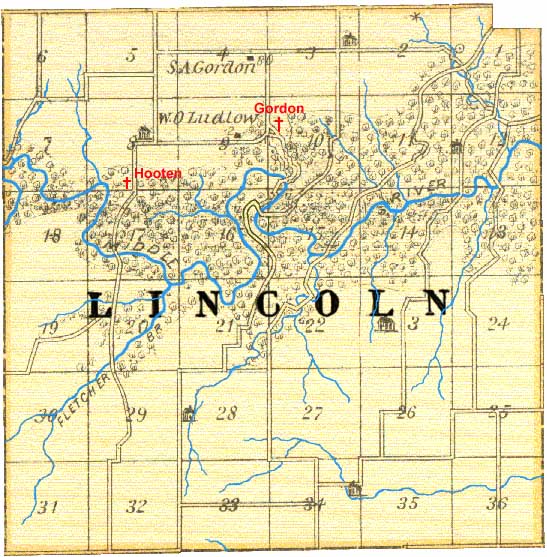|
Madison County |
|
History This township is bounded on the north by Douglas, on the south by Monroe, on the east by Scott, and on the west by Webster. It is drained principally by Middle river, which passes through it from west to east a little north of the center. It abounds in heavy timber along the course of this stream. Heavy deposits of limestone are found, and also some coal along the banks of the river. The surface presents considerable variety , being much broken along the course of the river, while to the north and south is high, rolling prairie land, admirably fitted for farming. The first settlers located in the timber along Middle river. The first to come were Absalom Thornbrugh, C. D. Wright and Daniel Vancil, who came in 1847. James Bertholf and Elijah Perkins came in 1849. Alexander Bertholf and his sons, together with Joshua Gentry and John Heaton, came in 1850. John Macomber, Wm. Harman and L. D. Skidmore came soon after. As early as 1852 this township had two of the original pioneer mills known as "corn crackers," along Middle river. They served as saw-mills and also for grinding corn, and were erected by James Bertholf and Mr. Hogg. The "Madison Woolen Mills" were built in this township in 1865, at a point on the Council Bluffs road about one and one half miles west of Winterset. J. T. White and N. W. Munger were the proprietors. The building was of stone, forty by fifty feet, three stories high, and with a wing twenty by twenty-five feet, with room for engine, boiler and dry room. In addition some half dozen dwellings for operatives, ware-rooms, etc. The machinery for this establishment was manufactured expressly for Messrs. White and Munger, at Lawrence and Worcester, Mass., and Staffordville, Conn., and comprises two pickers, one duster, two setts 40 inch manufacturing cards, two double acting roll cards, two 240 spindle jacks, one fifty spindle twister, one three yard wide fancy Crompton loom, one yard wide fancy Crompton, two yard wide Stafford, three two and a half yard wide Day and Lovejoy. This establishment employed some twenty hands, and the goods manufactured took a first premium at the district fair in Des Moines in 1868. These mills were destroyed by fire in 1877. It was a great loss as they had been for years the chief manufacturing interests of the county. A great natural curiosity in Lincoln township is described as follows: "About five miles west of Winterset, on Middle river, is a peculiar formation of nature bearing the euphoneous title of ' Devil's Back Bone' or ' Hogback.' This back-bone of his Satanic Majesty bears quite a local notoriety. If the ridge were surrounded by a large body of water it would simply be termed a promontory. As it is, it is merely a high, rough rocky ridge, so narrow that at the top there is only room for a wagon road. Middle river running from east to west, strikes this high ridge, which is over two hundred feet above the water level, and then bears in a circuitous rout away, and some two or three miles further down its course bends around until it passes on the other side of the same steep, high ridge. From water to water, directly through the ridge, is less than one hundred feet. An early settler in that neighborhood, named John Harman, together with his sons, tunnelled the ridge through solid rock, occupying three years time to do the work. They thus obtained a waterfall of twenty feet, making it the most desirable site for a mill in the western country. A large room has been made in the rock around the mill end of the race, making as delightful a bathing place as can be found anywhere. A large gristmill and saw-mill has lately been erected at this point by Messrs. Wilkin and Co. This back-bone is quite a curiosity and worth going a long distance to see." The present officials are: Justice - Jeremiah Coakley; Trustees - Wm. Hartsock, A. Macomber, G. W. Tracy; Constable - T. E. Weeks; Assessor - James Bertholf; Clerk - Ezra Brownell.
Map Shown below is Lincoln Township as it appeared in 1875. There were about 200 families living in Lincoln Township in 1875, which was double the population of some of the other townships. Lincoln Township is bisected by the Middle River, entering in Section 18 and exiting in Section 12. The area along the river was heavily wooded and eventually, portions of Section 15 &16 became Pammel State Park. The two cemeteries shown have been in use since the 1850s. |
|
|
|
Lincoln Township - 1875 |
| Maintained by the County Coordinator |
|
This
page was created on July 23, 2004. This page was last updated Thursday, 13-Apr-2017 16:03:49 CDT . |



